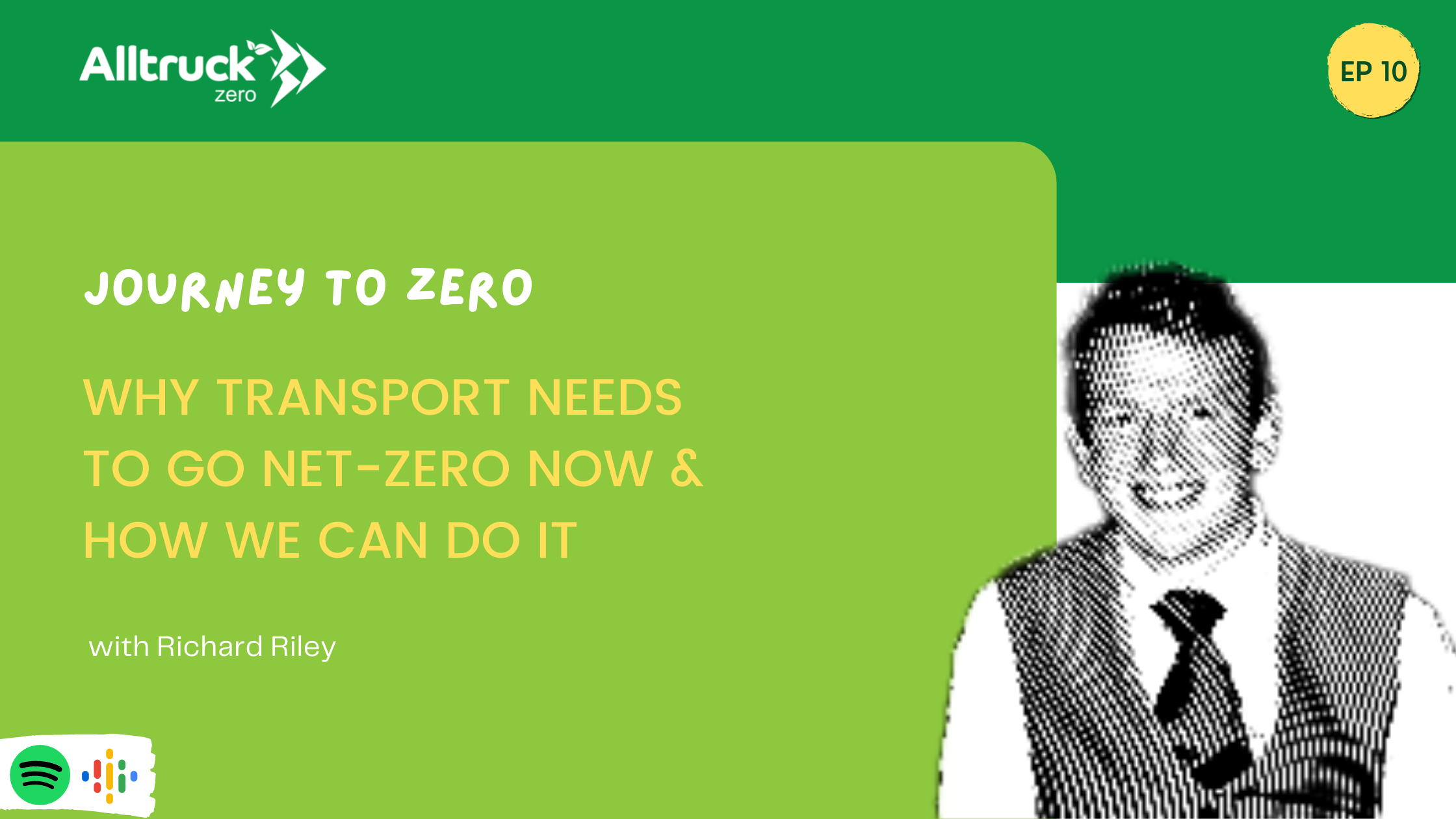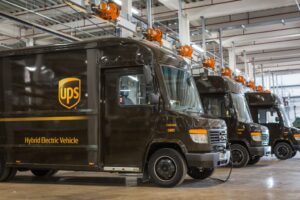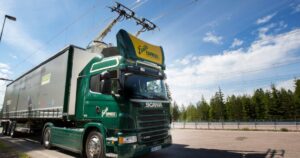
Last month, I had the pleasure of talking to Richard Riley, a Senior Principal Consultant at Element Energy, who has a wealth of knowledge in all things low and zero-emission. Richard has been working at Element Energy for the past six-years after attaining his PhD at Leeds University in Low Emission Vehicle Technologies.
Element Energy is a low/zero-carbon energy consultancy that specialises in transport, energy networks, constructions, smart energy systems, and hydrogen fuel cells.
It was fantastic to welcome Richard onto the show, and it was a wonderful chat that answered many of the big questions and concerns a lot of individuals have about moving over to electric and alternately fuelled commercial vehicles, such as:
You can listen to the full episode of our chat with Richard here:
[3.54] Hannah: How did you get into the low and zero-emission side of transport?
Richard: I did Environmental Engineering as an undergraduate.
So, right from the early days at university, I had lectures on the impact of climate change, the emissions from industries, including transport. I’ve also always had an interest in cars since I was a kid, so I basically just joined those two together.
It was a no-brainer to then come to Element Energy, there are very few consultancies in the UK that purely focus on the low carbon area. Since then, I’ve seen the low carbon agenda accelerate hugely.
[5:15] H: Can you reiterate why it is so important that we all strive to get to Net Zero?
R: We’re already seeing the knock-on effects of producing more and more greenhouse gas emissions around the world. Whether that be droughts, flooding, hurricanes – all these types of things. These then have a huge effect on the everyday lives of people, our supply chains, access to food, and access to housing.
The real concern is that we will impact significant areas of the globe, to the point that they are no longer stable places to live. That would then lead to massive migrations of people, away from those areas, looking for more stable regions to call home.
As we’ve already seen with the unrest in the middle east, and therefore people trying to move to Europe, that has huge political knock-on impacts. This then becomes a hugely contentious issue about sharing resources and creates a huge amount of conflict.
This is not the kind of future we all want.

[7:13] H: What’s your mission and place in helping us tackle this?
R: When we produce greenhouse gas emissions they stay in the atmosphere for a very long time. CO2 is around for 100+ years, so everything we pollute now will be in the atmosphere in 2050 when we’re aiming for that net-zero target.
What this means is if you can reduce some emissions today, over time it will save up a huge amount.
For example, if you don’t pollute a tone of CO2 in 2020, and do the same in 2021, 2022, 2023. Keep adding that up, and by the time you get to 2030, you’ve saved 10 tonnes of CO2.
If you made the same action in 2030, you’ve only saved 1 tonne of CO2.
Therefore, acting early has this cumulative, positive benefit.
For me, the real mission is what can achieve by 2030? Everything we do in this decade has this enormous potential benefit.
We have this split of two worlds. If we do nothing between now and 2030, the options of what future we will have after then will be quite limited. We will have the choice of not very good, bad, and really bad. But if you act before 2030, we will have more options. You can choose between good and bad.
My mission is to see what radical change we can deliver before 2030, so that whoever is here in 2030, they have the same options as we do today. I want to pass on to the next generation the same opportunities we had.

[11:21] H: With HGVs being tricky to make low or zero-emission. What can we do? Is the Government setting a fair target by saying that by 2050 new HGVs will all have to be zero-emission? Or do we need to do more?
R: HGVs are about 16% of UK domestic transport, so it’s quite a reasonable chunk. Unlike cars, they don’t have a broad range of options. With personal cars, you can encourage people not to take certain trips, you can encourage them to walk, cycle, ride-share or take the bus. You can encourage them to use zero-emission vehicles. There are all these different pathways to reduce emissions.

With HGVs, you have potentially some options to use rail for certain routes, but for a large proportion of it, you need to decarbonise the vehicle itself as quickly as possible.
The UK Government set out these targets. For under 26T’s, we’ll stop selling polluting vehicles in 2035; over 26T, 2040.
I think those targets are fine. It sets an end date, and it begins to focus the mind on what we need to achieve. Within those targets, companies can still transition to that date in a number of different ways.
You could do absolutely nothing, and then start buying zero-emission vehicles in 2040. Or you could ramp up your decarbonisation strategy very quickly through parts of your fleet that can decarbonise sooner and leave the more difficult bits until last.
Those two pathways have very different cumulative emissions over time, as I mentioned before.
I think the government targets are fine at setting an end goal, but what we now need to do is think about how we get there in a way that reduces emissions as quickly as possible.
I see the next key step being to break the fleet up, understand what all the different vehicles in your fleet are doing and then you can start to set your own goals. For example, the first 10% could go over to zero emissions next year, the next 10% in 2025, and so on. It’s keeping an eye out on what’s on the market.
[15:19] H: What are your thoughts on the options we have out there today for commercial vehicles?
R: Thinking about the whole HGV market as one thing is a bit difficult here. There is a major chunk of the market that could be electrified very quickly.
For example, UPS has had electric trucks running in London on delivery routes for several years now. Tesco has said all their vehicles doing home deliveries will be electric by 2028. There are big chunks of the market where there’s no reason to wait and they can go directly electric.

On the other end of the market, we have a 44t articulated truck that is double shifted. Running all day, changes driver, then running all night. For those options, it’s going to be a while before there’s a zero-emission vehicle ready to work in that scenario.
However, there’s absolutely no reason we wouldn’t use HVO or biomethane as a kind of steppingstone to deliver emission reductions before 2030 whilst the zero-emission technology is ramping up, decisions are made about which is the winning technology and the infrastructure is being rolled out.
[20:51] H: Could you share your thoughts on the government zero-emission HGV trials that are taking place across the UK?
R: Hydrogen, Battery Electric Vehicles and Electric Road Systems are the leading contenders.
You’ve got different groups and different OEMs are backing these different technologies.
This is a problem that operators and government have, if OEMs and the research community can’t agree, then how do they agree?
For comparison across the three of them…
In terms of the battery-electric vehicle with stationary charging, we’re expecting to see significant cost reductions in the future following the results of the car market. The problem with BEVs is the range and flexibility. If you’re wanting to double shift your vehicle, you’ve got very little time to charge your vehicle in between shifts.

The eHighways, or Electric Road Systems (ERS), is specifically designed to cure that problem. You don’t have to wait to charge because you’re charging on the move, so it gives you that flexibility. The drawback is you need high utilisation of the infrastructure to get the costs down. That means everyone must buy in and agree on this technology as the winner.
And that’s not just buy-in in the UK, you would want multiple countries across Europe to agree on implementing eHighways, so you can move across borders with that technology.

As we’ve seen with all large infrastructure projects, getting that buy-in and commitment within one country is really difficult, so across multiple countries, it will be a massive challenge. So it comes with that risk, we know ERS works, but operators need to be confident that the investment and commitment are there to finish the network. You can’t do what the government’s done with the HS2 rail line and decide halfway through planning that they’re not going to do half the network. With ERS, we need to finish the network. With the ERS, it feels like we need strong government support and assurances.
The third one, hydrogen, feels like it could be more of an industry-led technology. It very much mirrors the kind of market we have today. Like ERS, it has that flexibility as you can refuel very quickly with it. The major challenge with hydrogen, unlike the electric side, where you might pay more for the vehicle, but you pay very little for the electricity, and therefore one balances the other. On the hydrogen side, we’re still a long way off hydrogen being a similar price to diesel. So you’re paying more for the vehicle, but you’re also paying more for the fuel. There’s no real cost balance for the operator.
Hydrogen also has to be produced. It’s either being produced from electricity, or from natural gas with carbon capture and storage. Both are hugely energy-intensive processes. It brings up questions like ‘Where’s the infrastructure coming from?’, ‘Who’s building all of the infrastructure to supply the hydrogen?’.
If it’s green hydrogen from green electricity, we need a lot more wind turbines and a lot more solar panels. We already don’t have enough of them to cover our current electricity usage.

If it’s blue hydrogen with carbon capture and storage (CCS), the UK’s been trying to run a CCS trial for the last 10/15 years, and it still hasn’t happened. Putting all your money behind blue hydrogen, and a technology the UK has never actually been able to deliver, again you’ve got this huge risk that you build the hydrogen fuel stations and the vehicles come along. If that CCS technology isn’t ready, then you haven’t actually delivered any decarbonisation.
It’s not clear that any one of these technologies is better at getting everything they need ready at the same time, in the same place and at the right cost.
The way we’re approaching this issue in our current projects is that we see battery-electric vehicles working for a significant proportion of the market, both rigid and artics. As this technology improves, it will expand that market. That will deliver us emission savings as quickly as possible.
Supporting that, we’re involved with zero-emission freight trials and we’re constantly talking to operators and bringing together all the evidence on these three technologies.
[29:13] H: With any new technology, there’s a lot of scepticism and a lot of doubt whether it will work. Or, in this case, whether it is actually better for the environment. What would you say to those who are sceptical about these new truck technologies?
R: I think people just really need to look at what’s happening in the car market and the electricity market.
In terms of those concerned about the energy side [e.g. electric cars being powered by electricity generated with fossil fuels], the carbon intensity of the UK grid has fallen dramatically over the last 5 years. The government last year [2021] came out and said that they were going to decarbonise the grid by 2035. From that side, I don’t see any real concerns.
In terms of recycling batteries, we’ve got an increasing number of regulations being debated about recycling batteries from the automotive market. There’s a big piece of regulation being discussed in the EU, and I’m expecting the UK will be doing very similar, which will say to the OEM, over time an increasing percentage of the battery that you put in a vehicle must be recycled end of life. That very quickly ramps up into 90% + of the content being recycled.

This actually makes huge economic sense as well because we’re seeing the price of all these battery components go through the roof (e.g. Nickel, Cobalt), so why wouldn’t you recycle them and have those materials back in the supply change? I don’t think there’s really any chance of automotive batteries ending up in the bin. They’re hugely valuable, and regulation won’t allow that.
In terms of producing the vehicle, there’s a trend in the car market that hasn’t made it into the truck market yet, but I think it will over time. OEMs are now beginning to set emission targets for the whole production of the vehicle, and that’s across the whole supply chain, not just their part of producing the vehicle. That very quickly cleans up the whole process.
[41.11] H: What about the infrastructure for battery-electric trucks and vans, which are substantially larger than cars, will we be seeing public chargers for bigger vehicles become more prevalent?
R: This is an important first step, we need to quickly start de-risking access to infrastructure for all different vehicles.
For smaller trucks and vans, they are probably likely to share the car charging infrastructure. There’s going to be a lot more car charging across cities.
For bigger trucks, they’re largely going to want to charge on the motorway network. Service stations are very poor even for diesel trucks, so what we really need is a planned response to introduce showers, toilets, comfortable rooms, and chargers for HGVs on the motorway network.
GRIDSERVE has opened its first charging location, and it’s got everything. Large numbers of chargers, easy access bays, and high-power charging. Really nice facilities for shopping, eating, everything is all together. That is what we need for the truck market.

Yes, it is difficult and there are major challenges, but it just means we need to start planning early to make sure it’s done properly.
For more information about Richard Riley and his work at Element Energy, you can find him on LinkedIn or email him here: Richard.Riley@element-energy.co.uk
To find out more about how Element Energy could help you (they support anyone from a one-man band to huge fleets), you can find them on their website here: element-energy.co.uk
To find out more about alternative fuels, eHighways, and the effect of tyre dust, you can listen to our other podcast episodes via Spotify, Google Podcasts, or Anchor. Happy listening!